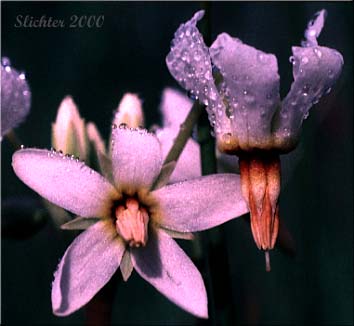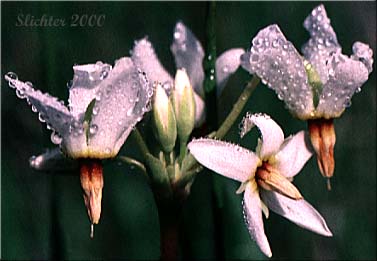 The
photo at right is a close-up of the corolla of few-flowered shooting star from meadows along the North Fork of the Crooked River near Big
Summit Prairie, Ochoco National Forest. Note that the variety monanthum
has purplish filaments and may have populations of flowers mixed in with white
flowers.
The
photo at right is a close-up of the corolla of few-flowered shooting star from meadows along the North Fork of the Crooked River near Big
Summit Prairie, Ochoco National Forest. Note that the variety monanthum
has purplish filaments and may have populations of flowers mixed in with white
flowers.
Few-flowered shooting star is an attractive perennial which should be fairly easy to grow in the garden meadow or rock garden. The erect stem rises 5-40 cm from a basal rosette of pale green, oblong to spoon-shaped leaves from 3-20 cm long. The leaves taper to winged petioles. The herbage of the leaves and stems is usually smooth-surfaced.
The 3-12 flowers have 5 floral parts. The corolla is 15-25 mm across with deep magenta to lavender petals 1-2 cm long and reflexed sharply backwards.. The tube at the base of the petals is white or yellow-ringed with a thin, wavy reddish-purple ring at the very base. The filaments are united to form a tube of yellow or purple anthers projecting to 1 cm from the mouth of the corolla tube. The anther connectives are smooth and and the stigma is not enlarged at the end of the style.
ssp. macrocarpum: filament tube yellow, anthers 5.5-7 cm long. found in the Columbia Gorge, Willamette Valley and adjacent foothills.
ssp. monanthum: filament tube reddish purple, anthers 3.5-5.5 mm long. Found at scattered sites east of the Cascade Mts (to eastern Oregon, northeastern California, and Utah), Willamette Valley, and Siskiyou Mts..
ssp. pulchellum: filament tube yellow, anthers 3.5-5 mm long, plants usually greater than 6 cm. Widespread east of the Cascade Mts..
Few-flowered shooting star is found in sagebrush and moist meadows and streamsides from lower elevations to subalpine habitats.
Few-flowered shooting star may be found from Alaska to Mexico and east to Pennsylvania and Utah.


